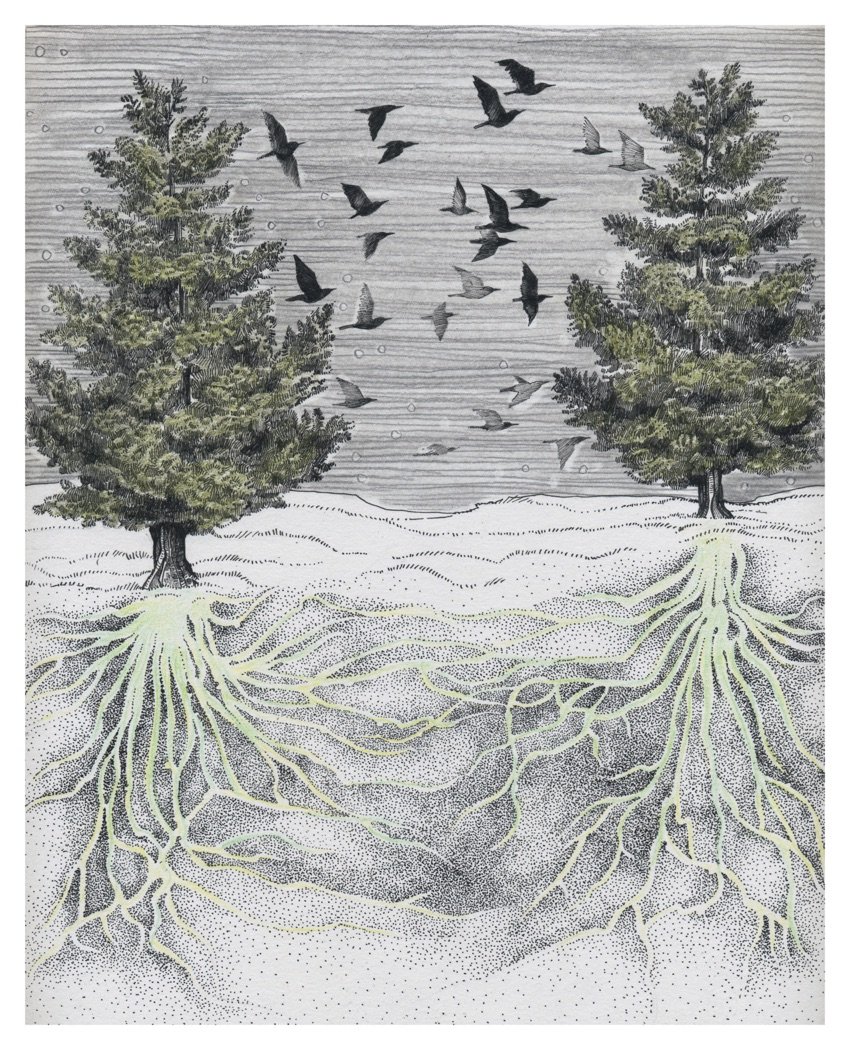 Image 1 of
Image 1 of


WOODS-WIDE WEB 8" x 10" print
“Science asks us to learn about organisms. Traditional knowledge asks us to learn from them”.
-Robin Wall Kimmerer
This artwork is from a 2022 wall calendar project and is exploring how change happens in the more-than-human world. What is the pace? What is the scale? The catalysts, the intelligence, the resources? The plants and animals are powerful teachers and offer abundant examples of how, specifically, to practice a cooperative, interconnected life. Here I explore examples of Pollination (sharing), Metamorphosis (forming), Germination (growing), and Decomposition (Dying). Each monthly page includes a few questions about how these examples might translate to human experiences.
Germination: GROWTH. CONNECTION. MYCORRHIZAL NETWORKS. Studies show that trees use underground hyphal networks created by mycorrhizal fungi to communicate and share resources. When an individual tree is attacked by a fungal pest, the tree can send a warning to the neighboring forest. They do this even after it is too late for them to recover. This concept undermines the idea that nature constantly competes for survival. Have you been taught that competition is the norm? If so, what would it take for you to shift that thinking? Are you willing to choose collaboration instead?
“Science asks us to learn about organisms. Traditional knowledge asks us to learn from them”.
-Robin Wall Kimmerer
This artwork is from a 2022 wall calendar project and is exploring how change happens in the more-than-human world. What is the pace? What is the scale? The catalysts, the intelligence, the resources? The plants and animals are powerful teachers and offer abundant examples of how, specifically, to practice a cooperative, interconnected life. Here I explore examples of Pollination (sharing), Metamorphosis (forming), Germination (growing), and Decomposition (Dying). Each monthly page includes a few questions about how these examples might translate to human experiences.
Germination: GROWTH. CONNECTION. MYCORRHIZAL NETWORKS. Studies show that trees use underground hyphal networks created by mycorrhizal fungi to communicate and share resources. When an individual tree is attacked by a fungal pest, the tree can send a warning to the neighboring forest. They do this even after it is too late for them to recover. This concept undermines the idea that nature constantly competes for survival. Have you been taught that competition is the norm? If so, what would it take for you to shift that thinking? Are you willing to choose collaboration instead?
“Science asks us to learn about organisms. Traditional knowledge asks us to learn from them”.
-Robin Wall Kimmerer
This artwork is from a 2022 wall calendar project and is exploring how change happens in the more-than-human world. What is the pace? What is the scale? The catalysts, the intelligence, the resources? The plants and animals are powerful teachers and offer abundant examples of how, specifically, to practice a cooperative, interconnected life. Here I explore examples of Pollination (sharing), Metamorphosis (forming), Germination (growing), and Decomposition (Dying). Each monthly page includes a few questions about how these examples might translate to human experiences.
Germination: GROWTH. CONNECTION. MYCORRHIZAL NETWORKS. Studies show that trees use underground hyphal networks created by mycorrhizal fungi to communicate and share resources. When an individual tree is attacked by a fungal pest, the tree can send a warning to the neighboring forest. They do this even after it is too late for them to recover. This concept undermines the idea that nature constantly competes for survival. Have you been taught that competition is the norm? If so, what would it take for you to shift that thinking? Are you willing to choose collaboration instead?